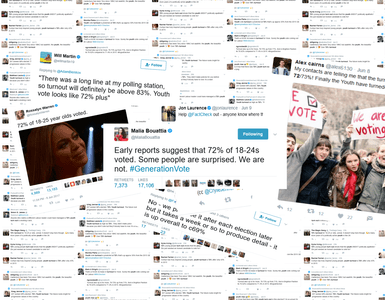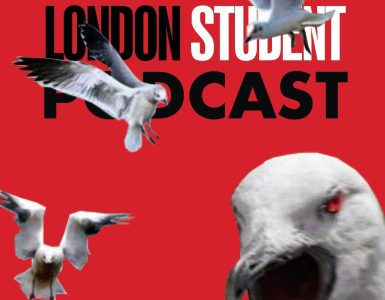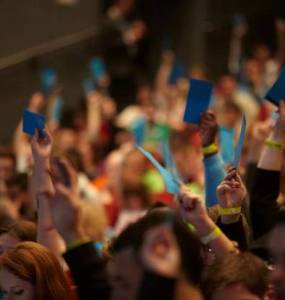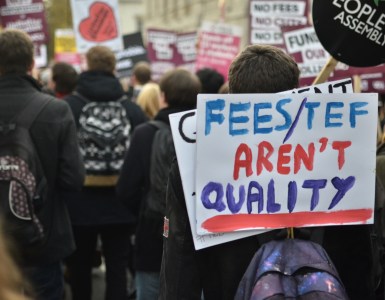If, over the last few days, you’ve heard that 72% of 18-25s voted, then you’re not alone. That statistic, which points hopefully to a revival among youth turnout, has been shared by publications and journalists including LBC, The Metro and the FT. The problem? There’s no evidence it’s true.
At 7.23AM on polling day, journalist Adam Bienkov reminded his followers not to take anecdotal turnout reports seriously. One of his colleagues tweeted back, in jest:
“There was a long line at my polling station, so turnout will definitely be above 83%. Youth vote looks like 72% plus”
— Will Martin (@willmartin19) June 8, 2017
His comic tweet is the first tweet on election day involving the 72% figure. By the end of the day, it was in national news reports.
The first person to go viral with the figure, and the person cited in most news reports, is outgoing NUS President Malia Bouattia, who is yet to respond to requests for a source.
She follows Huffington Post blogger and chair of Youth Vote UK Alex Cairns, who also tweeted the figure. He told the BBC that it was based on his own research, but declined to share his methodology.
Bouattia’s tweet landed at 5.46pm, according to the timestamp on twitter. The next viral tweet with the figure, from Rossalyn Warren, a freelance journalist, came in nearly six hours later, at 11.04.
A short while later Labour MP David Lammy tweeted the same number, and received more than 25,000 retweets. Then the number came from the Financial Times political editor, Jim Pickard, and after that a deluge of other twitter users.
The next morning, June 9th, it hit the news. The Metro reported that 72% of young people turned out, citing “the head of the NUS”. The Evening Standard’s story didn’t cite anyone, only saying that the figure was “estimated”. LBC, The Mirror, Esquire and others reported it. Student papers, including The Tab and University of East Anglia’s Concrete, picked up on the figure too.
The figure even went international, with Pakistani columnist Mosharraf Zaidi sharing it to his 127,000 followers. Charities, local parties, schools (including City and Westminster College) tweeted about the incredible youth turnout.
The spread of the 72% figure is a chain of missed opportunities for correction. When Cairns first shared it, he could have prevented a viral fake news story by making his methodology clear early on. Bouattia could have checked with him regarding how he found the number, and added a caveat to her tweet - or replied to some of the many people asking her for a source. Journalists using her tweet as a source could have waited for verification, and when none was forthcoming dropped the story. Yet nobody did.
James Ball, Special Correspondent for Buzzfeed, is the author of Post-Truth: How Bullshit Conquered the World. Writing in the New Statesman, he noted that we are far less likely to critically check ‘facts’ which support our views.
He writes: “By instinct, we tend to look for fact-checks and sceptical takes on narratives that conflict with our existing politics: if we’re liberal, we’re unlikely to have thought Hillary Clinton’s email scandal was a big deal, and would likely be sceptical of the Benghazi probes from Congress.
“If we’re a Donald Trump supporter, we’re not all that likely to think the allegations around Trump’s ties to Russia are particularly credible. We need to try to jump back from this and look for sceptical takes on the attack lines we believe – and also try to give credence to attack lines on causes and candidates we like.”
This helps us to understand why the statistic was so easily believed. We’d love for 72% of young people to vote, because that would reverse the trend of low youth turnout and force politicians to consider all demographics in manifestos. For politically-engaged young people like Bouattia or Cairns, they’re not likely to be sceptical of a statistic that confirms what they believe - that young people are, or should be, politically enfranchised.
The same fake story appeared in reverse after the EU Referendum last June. Early claims on social media, that less than 40% of young people had turned out, were widely reported but proved false; the actual turnout was closer to 65%.
That time, claims of low turnout helped Eurosceptics to argue that young people were apathetic towards the EU and, although Brexit will affect the young more, the high support for the EU among young voters could be ignored.
Meanwhile, the 72% figure keeps spreading, with the help of excited twitter users, unscrupulous journalists and NUS operatives. Newly-elected NEC member Ali Milani cited it on TV on the 11th, despite several news organisations having debunked it. Until research is completed and actual figures published, the fake story will likely continue to spread.








PLEASE READ!!
Hey Guys!!!I am Henry i live in Texas USA, Am so happy I got mine from Annie. My blank ATM card can withdraw $3,000 daily. I got it from Her last week and now I have $9,000 for free. The blank ATM withdraws money from any ATM machines and there is no name on it because it is blank just your PIN will be on it , it is not traceable and now i have money for business,shopping and enough money for me and my family to live on .I am really glad and happy i met Annie because i met Five persons before her and they took my money not knowing that they were scams. But am happy now. Annie sent the card through DHL and i got it in two days. Get your own card from her right now she is not like other scammer pretending to have the Blank ATM card,She is giving it out for free to help people even if it is illegal but it helps a lot and no one ever gets caught or traced . im happy and grateful to Annie because she changed my story all of a sudden .The card works in all countries that is the good news Annie’s email address is anniemellor233@yahoo.com,